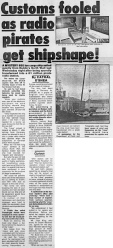© 2014-


Radio Paradijs - History
Shortly after the Mi Amigo sank in March 1980 plans for a new offshore radio station were put together by some people who had been involved in the Dutch side of Radio Caroline. These included Ben Bode and Danny Vuylsteke who joined forces with A J Beirens, formerly a presenter on RNI's World Service in the early 1970s and who since then had been involved in various Italian land-
The proposed station -
Through a broker they purchased a ship, the coaster, Hoheweg, which at that time was moored in Krausand, but later moved to Cuxhaven, where she was berthed and re-
Because of this intense interest it was decided that the Lieve should sail from Cuxhaven and she headed for Ireland to be finally fitted out as a floating radio station. The Lieve eventually arrived in Dublin on 11th March 1981.
It was intended that the ship should be used to broadcast three separate programmes -
At an early stage in the planning process proposals had been announced for a medium wave station serving most of northern Europe -
Three transmitters arrived from the USA at the beginning of July 1981, and were installed on board the Lieve, but by then there was increasing press interest in what was going on with the mysterious ship in Dublin Harbour. Because of this interest arrangements were hurriedly made to finish equipping the Lieve and get her out of port before the Irish authorities had an opportunity to act.
These panic-
Only five hours into the voyage from Ireland the ship encountered storms and the top sections of the hastily erected aerial mast came down. The Lieve battled on through the English Channel into the North Sea, but was eventually forced to anchor temporarily five miles from the former REM Island (home of Radio Noordzee/TV Noordzee in 1964) off the Dutch coast on 20th July 1981.
After repairs had been carried out to the damaged aerial mast at sea some night-
An aerial photograph of the new radio ship published in the Dutch daily newspaper De Telegraaf on 29th July 1981 concerned and disturbed the authorities because it appeared to show the vessel was carrying a satellite dish. Questions were raised in the Dutch Parliament and the Minister of Telecommunications ordered a police and Navy raid on the radio station's vessel. This action was supposedly justified on the grounds that there were Dutch nationals on board the ship -
The radio ship, by now known as the Magda Maria, was raided at 5.30am on 1st August 1981 by Dutch police and marines and three crew members were arrested. Although the radio station was not broadcasting at the time of the raid the authorities discovered two irregularities with the ship herself -
now known as the Magda Maria, was raided at 5.30am on 1st August 1981 by Dutch police and marines and three crew members were arrested. Although the radio station was not broadcasting at the time of the raid the authorities discovered two irregularities with the ship herself -
On instructions from the Dutch Public Prosecutor the Magda Maria was then towed into port and searched by the Navy who later moved her to Amsterdam, where the radio equipment was removed and put into storage.

Dutch police board the Magda Maria, 1st August 1981
Television news reports about the arrival of Radio Paradijs and the towing in of the Magda Maria.
July/August 1981

Click on picture to enlarge

Sunday World (Dublin)
19th July 1981
History
Key Dates
Ship and Location


Technical
Staff


Programmes



Irish Independent
3rd August 1981

Back to Netherlands/Belgium Gallery


Back to Radio Paradijs

‘Mighty 690’ Sales Brochure





Click images to enlarge